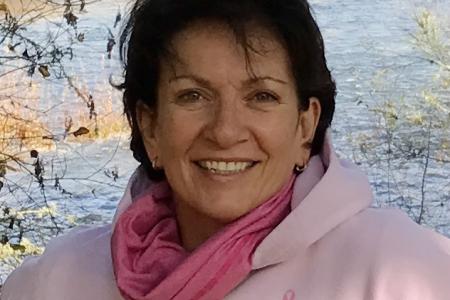“I googled best online degree programs for women. Simmons popped up and my search was over,” says CompleteDegree@Simmons student Diane Junker ’22. She wanted to complete the Bachelor’s degree she started 38 years ago, and has since discovered a passion for visual communications and graphic design. “I was impressed by the dedication to women’s education, and the history. Simmons was established in 1899 to help women become financially independent. How was that even in anyone’s vocabulary at that time? That first impression was amazing.”

For Shreve Cameron ’22, enrolling in the online CompleteDegree program was a return to Simmons. In 2014, she had a handful of courses left in her course of study when she took an internship in New York City. That internship turned into a job, which led to other job opportunities in the city. “I wanted to go back and finish, but I couldn’t find the time,” says Cameron. “During COVID I moved to the Berkshires and applied just as CompleteDegree was launched. The timing was perfect.”
The two met online in Professor of Practice Mary Shapiro’s Organizational Communication & Behavior class (BUS 234) and paired for a semester-long project to collect market data and create a business pitch for a product. The idea for their project arose organically, inspired by the vision board Cameron had displayed on the wall behind her during online classes. Their product would be a vision board kit, and they were inspired. “We must have sent each other fifty emails that first day, we were so excited,” says Cameron. They did research on Etsy, an online marketplace for handmade goods, to see what types of vision boards were already on the market. “We found over 6,000 listings for vision boards,” recalls Junker. “It was a sea of pastels, mostly pink, and tan.”
Market saturation did pose a challenge, but the pair did not give up. “We thought of what could be useful for today’s climate,” says Cameron. “We looked into the statistics and found that depression, anxiety, and addiction is rampant in the U.S. We both have personal connections to recovery of some kind, so we thought, what would be helpful?” They created a vision board kit with different themes of recovery, using magnetic image and message cards to allow users to redesign their board as needed, as well as recovery meditation cards and crystals to act as reminders of mindfulness. A blog would serve to promote the use of the product and offer advice and support, along with an online forum for people who want to discuss their recovery.
After presenting their first draft to Shapiro, they had constructive feedback to act on. “It’s not something many real life entrepreneurs do well,” noted Shapiro. “In response to what they heard from different stakeholders, Shreve and Diane made some significant modifications to their original idea, which greatly increased the likelihood of the product’s success.”
Cameron and Junker completed roughly seven iterations before the final business proposal. “It was a long process, but rewarding,” says Junker. “I learned resilience. In the past, I was afraid to put my work out there, afraid that people would see that I didn’t know what I was doing. This helped me get past that.” Cameron used it as an opportunity to reflect on success and recovery. “It’s a competitive world, and people are often afraid to come forward to talk about a problem. The best thing you can do is to seek help and solutions instead of suppressing your feelings.”
They also found the course itself enlightening, given Shapiro’s inclusion of personality diagnostics to determine individual strengths and communication styles. “This class would be perfect for all first-year Simmons students,” says Junker. “We learned about ourselves first, and were able to identify what we brought to the table. Knowing that is enormous, and it’s given me a new sense of pride. I have such gratitude for Simmons. I never would have imagined having this kind of experience going back to college.”

